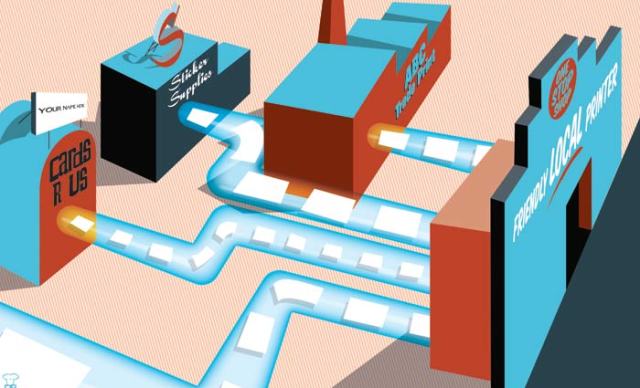Sanxin (pronounced ‘san-sin’) began life in 1992, making desktop litho presses that the domestic Chinese market used as heavy-duty photocopiers. The two-colour at Ipex, the YK522, was the company’s first free-standing machine, but so encouraged was Sanxin by its success that it has now launched a multicolour model, the YK524, which was shown at drupa. “Response has been excellent,” Moorby says. “Gone are the days when people thought Chinese engineering was second-rate – I don’t have to twist anybody’s arm to get them to look at it.”
The 524 isn’t highly automated, but it does have a semi-automatic plate loading device included as standard; and while it’s not CIP4/JDF compatible, it can take information on ink curves direct from the platesetter for presetting the ink keys before the run begins. (Printers who aren’t running CTP can manually set ink keys via the control desk.) The control desk itself is also replicated at both the feed and the delivery end of the press, meaning operators can work remotely or at either end of the machine directly.
But the YK524 focuses less on automation than it does on optimised manual procedures for makeready and on-the-run adjustment. Dampening is a metered alcohol system (that can also run alcohol substitute founts) with chilled recirculation; the metering roller is driven by a servo-motor, so very fine adjustments can be made independently of the speed of the press. There’s also a vacuum feed board, which makes for minimal furniture on the infeed, and a pull sidelay, which registers sheets positively as they go into the press; ultrasonic sensors on the feed board read the sheet thickness and set the infeed mechanics accordingly. There’s an automatic ink sweep feature, which basically relieves the press operator of the need to run up and down the press pulling levers to get the ink into the ducts, and the ink ducts are laser-cut into 16 segments for fine settings.
The YK524 also sports a static elimination device, on-the-run remote micro-adjustment of the cylinders in all three planes, a central lubrication system that pulses automatically while the machine runs or manually after a shutdown, and a laptop diagnostic facility, “so an engineer can plug in a laptop and reprogramme any aspect of the system,” Moorby explains.
Double-diameter impression cylinders, as tried and tested on other small offset presses, make for fewer gripper changes, which cuts down on misregistration and marking. And another feature seen on many small offset presses is the large-diameter transfer cylinder: so large that it has three sheets in contact with it at any one time. A large diameter allows the sheet to be kept relatively flat, which helps with the curling issue for a printer doing work-and-turn, or putting down a lot of ink or water.
Another clever feature is the YK524’s fast wash-up feature: it’s not automated, but it goes a long way towards making the process easier, less messy and a bit quicker. The operator pulls up a lever on the unit, which releases the ink tray, doses the washing unit with washing fluid and presses a button to activate the wash-up routine.
Attractive prospect
On the down side, there’s no coater, and the YK524 can’t run as a perfector, although Moorby reports that Sanxin has heeded requests for both attributes and hopes to announce developments on both fronts by the end of the year.
Price, of course, is the Sanxin’s biggest draw. Although, as Moorby points out, it comes at the head of a long list of related factors: “It could be cheap as chips and nobody would buy it if it didn’t produce good quality print,” he says. He cites first the build quality of the YK524 – “it’s a fantastic, solid bit of engineering – they cast all their own metals on-site at the factory,” he says, and second, “the excellent print quality, with four forme rollers in each unit. We often get printers to bring along a demo job and we print that for them.” But price, he says, is the big factor that wins the day. “We’re half, sometimes less than half, the price of the European and Japanese machines.”
With prices that low, Printers Superstore has often found itself making sales against secondhand machines: “The choice is between the Sanxin and a 10-year-old Heidelberg,” Moorby says, “and printers are often tempted by a new machine with the latest features, plus a 12-month warranty.”
The column inches generated by Sanxin’s arrival in Europe two years ago have helped to put the YK presses on many printers’ maps, Moorby says. “We’ve just sold a machine to one printer who’s been an all-Heidelberg house for 20 years.” He lists the advantages of the Sanxin machines over equivalent European or Japanese models: “For a start, the capital cost is so much lower, the repayments are half what they’d be paying with another press. Then there are the consumables – we don’t charge an arm and a leg for rollers and blankets and wash-up blades like some other manufacturers. So, it’s not just a lower capital cost – the same level of reduced cost is reflected in the running costs of the machine.”
Fighting back, the Japanese and European manufacturers claim that the resale value of their machines is greater than that of the Sanxin machines. But Moorby laughs at this: “That’s just propaganda. You don’t buy a machine because it’s going to be worth X amount in five years’ time. Besides which, you’ll pretty much save on our machine, bought new, what you’ll lose in depreciation.” He cites a customer who bought a well-known German 52cm two-colour press three years ago, for $AU217,000, and for which he recently received a valuation of $AU103,000. “Which is near enough the price of our machine,” Moorby points out, “plus in the meantime he’s been paying through the nose for the consumables.” He also believes that resale values of the known manufacturers’ machines will likely take a knock from the Sanxin’s availability, “because we see so many people now who’d rather buy new than buy secondhand.”
Other press manufacturers mutter about the YK52 series’s design debts to other small-format offset presses, but Moorby isn’t bothered by it: “I’ve heard it said that it’s a copy of just about every small offset machine under the sun, but there’s only so many times you can reinvent the wheel – why not adopt successful working ideas?” He points out that the Japanese press manufacturers began “by stripping down the German machines and copying their assemblies, that’s how they got so good.” The important thing, he maintains, is that the YK524 is a solid piece of engineering that will turn out quality print. “Which it does, in spades, and nobody can argue with that.”
SPECIFICATIONS
Max sheet size 520x375mm
Min sheet size 280x150mm
Stock thickness range 0.04-0.4mm
Top speed 13,000sph
THE ALTERNATIVES
Hamada B452
The Hamada only has four colours (the five-colour is a separate model), not convertible to perfecting, no coater, and it runs slower than the Sanxin, although its level of automation is higher, with a fully automatic plate change, an auto blanket wash, and CIP4/JDF compatibility.
Max sheet size 520x365mm
Min sheet size 257x182mm
Stock thickness range 0.04-0.4mm
Top speed 10,000sph
Heidelberg Printmaster GTO52
Even though the basic chassis is nearly 30 years old, it still compares favourably to the Sanxin – and for not much more money. Optionally convertible to perfecting, one to five units, and the option for just about every bit of automation you could want, including a coater. Much slower than the Sanxin, though.
Max sheet size 520x360mm
Min sheet size 180x105mm
Stock thickness range 0.04-0.4mm
Top speed 8,000sph
Ryobi 524HE
Ryobi’s four-colour machine isn’t convertible to perfecting, and doesn’t offer a coater, but does have options for plenty of other automation including automatic ink presetting and ink cut-off (a full range of pre-sets comes as standard), on-the-run micro-adjustment of the cylinders laterally, vertically and diagonally, and optional CIP4/JDF compatibility.
Max sheet size 520x375mm
Min sheet size 100x105mm
Stock thickness range 0.04-0.4mm
Top speed 11,000sph
Shinohara 52IV
Comes in four, five or six colours with an option for a coater, although the convertible to perfecting ability is a separate model. Faster than any other 52cm press listed here, and with a good range of automation as standard – including ink duct presetting, blanket wash, dampening pre-set and on-the-run micro-adjustment of the cylinders.
Max sheet size 520x370mm
Min sheet size 148x100mm
Stock thickness range 0.04-0.4mm
Top speed 15,000sph
Read the original article at www.printweek.com.
Comment below to have your say on this story.
If you have a news story or tip-off, get in touch at editorial@sprinter.com.au.
Sign up to the Sprinter newsletter



